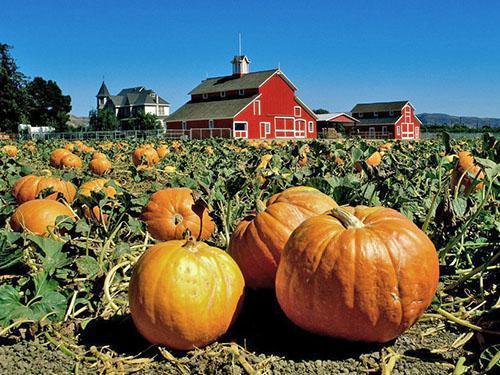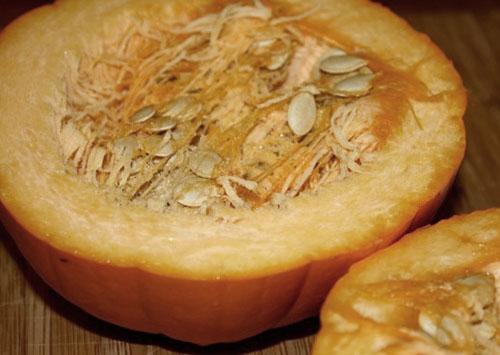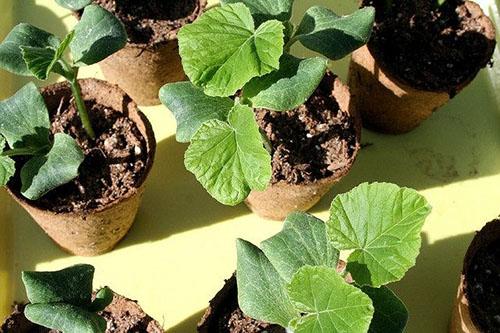Growing pumpkins in the open field in the country
 Among the melons and gourds, pumpkin produces outstanding fruits. The record holder is known, a pumpkin weighing 300 kg, obtained by a farmer in Central America. Giant fruits weighing 100 kg are not uncommon in our southern regions. Growing pumpkin in the open field is not a difficult task, but certain conditions for obtaining a good harvest must be observed.
Among the melons and gourds, pumpkin produces outstanding fruits. The record holder is known, a pumpkin weighing 300 kg, obtained by a farmer in Central America. Giant fruits weighing 100 kg are not uncommon in our southern regions. Growing pumpkin in the open field is not a difficult task, but certain conditions for obtaining a good harvest must be observed.
The benefits of pumpkin

Everything is useful in pumpkin - fruit pulp, seeds and rind. Even the inner fibrous part is a drug. There is vitamin T in pumpkin, which is rarely found in nature. Pumpkin pulp is used in cooking, it makes excellent healthy dishes. Pumpkin seeds are used for oil and are used to expel worms.
A fun Halloween holiday is not complete without dried pumpkins, from which images of mythical heroes are made.
Sweet butternut squash is especially appreciated. It is believed that this variety tastes better than others. It is poured, creating different shapes, and has a different color of the fruit. Small pumpkins are convenient to store in winter. On this topic:how is pumpkin useful for the human body?
Pumpkin planting and care in the open field through seedlings
 There are two ways to grow heat-loving vegetables:
There are two ways to grow heat-loving vegetables:
- seedling;
- sowing with seeds.
Pumpkin can be grown through seedlings in any area, in some places covering from early frosts.
Seeds must be pre-prepared, heated, soaked in ash or growth stimulants. Sometimes overdried, unprepared seeds cannot hatch. Therefore, it is better to germinate the planting material in moss, sawdust or a damp cloth, and sow with sprouts that have hatched.
The soil for seedlings is taken fertile, the cups are large. For germination, a temperature of about 20 degrees is needed, but the soil must not be overdried. therefore watering warm settled water will be useful. The cotyledon leaves stretch out quickly, so a place should be left for adding, but first, the long stem must be rolled into a ring and sprinkled with earth. This technique is called ringing seedlings. In the warm south window, the seedlings do not require illumination. It is planted in the ground at steady-state heat. The pumpkin likes to make a biological fire under it from plant debris, old sawdust, mullein silt of winter bedding from animals. Soil requirements:
- fertile light, melons and gourds should not be predecessors;
- open sunny place with a drawstring of tall plants on the north side;
- a hill with a deep standing of groundwater.
 Planting and caring for pumpkin in the open field is to protect it from pests and diseases. The same diseases that ruin the harvest of cucumbers can also harm the pumpkin. Therefore, watering the plants is carried out carefully, only with warm water and in a ring, without wetting the soil at the root. Water the pumpkins in moderation, increase the water supply during filling and stop for the ripening period. The root goes into the ground up to three meters, and even in a drought, the pumpkin will have enough moisture.
Planting and caring for pumpkin in the open field is to protect it from pests and diseases. The same diseases that ruin the harvest of cucumbers can also harm the pumpkin. Therefore, watering the plants is carried out carefully, only with warm water and in a ring, without wetting the soil at the root. Water the pumpkins in moderation, increase the water supply during filling and stop for the ripening period. The root goes into the ground up to three meters, and even in a drought, the pumpkin will have enough moisture.
Loves organic plant and mineral dressing... Fertilizing watering is done every week, alternating nitrogen and phosphorus-potassium fertilizers.The liana-like plant does not like the close proximity of other garden crops. She throws the whips far away, and in the internodes they put down additional roots, feeding the plant. However, the harvest needs to be regulated. The less pumpkins are tied, the larger they will be. The pumpkin is pinched, like the whips of a cucumber, not allowing it to grow. Giant fruits grow when one or two ovaries are left.
With the onset of morning frost, leaving a pumpkin uncovered in the garden is dangerous. Therefore, a temporary tent is erected over it or giant berries are cut. When the pumpkin ripens, its crust becomes hard and the tail dries out. But even unripe, it reaches a warm room in a few weeks. And small pumpkins after the New Year also have a yellow juicy pulp.
Sowing pumpkins and caring for melons
 Some early ripening varieties can be grown by sowing in the ground in central Russia. This variety includes Butternut, which ripens in 100 days, and Muscat, but it can only be grown by seedlings. Slightly more than 40 of 800 varieties of pumpkins are sweet favorites. In the south, the Dawn of the East, Gribovskaya Zimnaya are grown, gaining up to 12% of sugar. Very sweet, medium-ripening ones are Barn, Marble, Almond.
Some early ripening varieties can be grown by sowing in the ground in central Russia. This variety includes Butternut, which ripens in 100 days, and Muscat, but it can only be grown by seedlings. Slightly more than 40 of 800 varieties of pumpkins are sweet favorites. In the south, the Dawn of the East, Gribovskaya Zimnaya are grown, gaining up to 12% of sugar. Very sweet, medium-ripening ones are Barn, Marble, Almond.
 In the southern regions, for example, in the Crimea, melons with pumpkin are given a large area of farmland. Plants are sown into holes in several pieces, leaving one, the strongest plant. The soil for the pumpkin is allotted loose with a medium neutral in acidity. The predecessors can be any agricultural crops, except melons, so as not to transmit diseases and pests to related crops.
In the southern regions, for example, in the Crimea, melons with pumpkin are given a large area of farmland. Plants are sown into holes in several pieces, leaving one, the strongest plant. The soil for the pumpkin is allotted loose with a medium neutral in acidity. The predecessors can be any agricultural crops, except melons, so as not to transmit diseases and pests to related crops.
The main requirement for this culture is warmth. During the day, the temperature should be an average of 30 degrees, and at night 18. When pumpkin is being grown in the open field, pinching is mandatory. Overgrowth with excess green mass takes food from the fruit. But it is equally important to carry out plant protection measures. In large cooperatives, protection measures are chosen by specialists at home, it is better to use folk methods of struggle.
In personal farms, you can use modern tools that are allowed for use on your own subsidiary farms. Slugs are especially annoying, with which they fight, scattering lime around the plant, superphosphate, pine needles, or creating traps.
 Downy mildew and powdery mildew can ruin the harvest in a matter of days. Therefore, spraying against anthracosis and American dew is mandatory. When the pumpkin is ripe, it is determined by the condition of the rind. It should not be pressed by hand, and the tail should dry out. At the same time, the ripening period depends on the variety and can occur in 90 or 150 days. Late varieties have time to accumulate more nutrients and sugars. Even unripe, undamaged fruits turn yellow over time and have all the useful and taste qualities.
Downy mildew and powdery mildew can ruin the harvest in a matter of days. Therefore, spraying against anthracosis and American dew is mandatory. When the pumpkin is ripe, it is determined by the condition of the rind. It should not be pressed by hand, and the tail should dry out. At the same time, the ripening period depends on the variety and can occur in 90 or 150 days. Late varieties have time to accumulate more nutrients and sugars. Even unripe, undamaged fruits turn yellow over time and have all the useful and taste qualities.